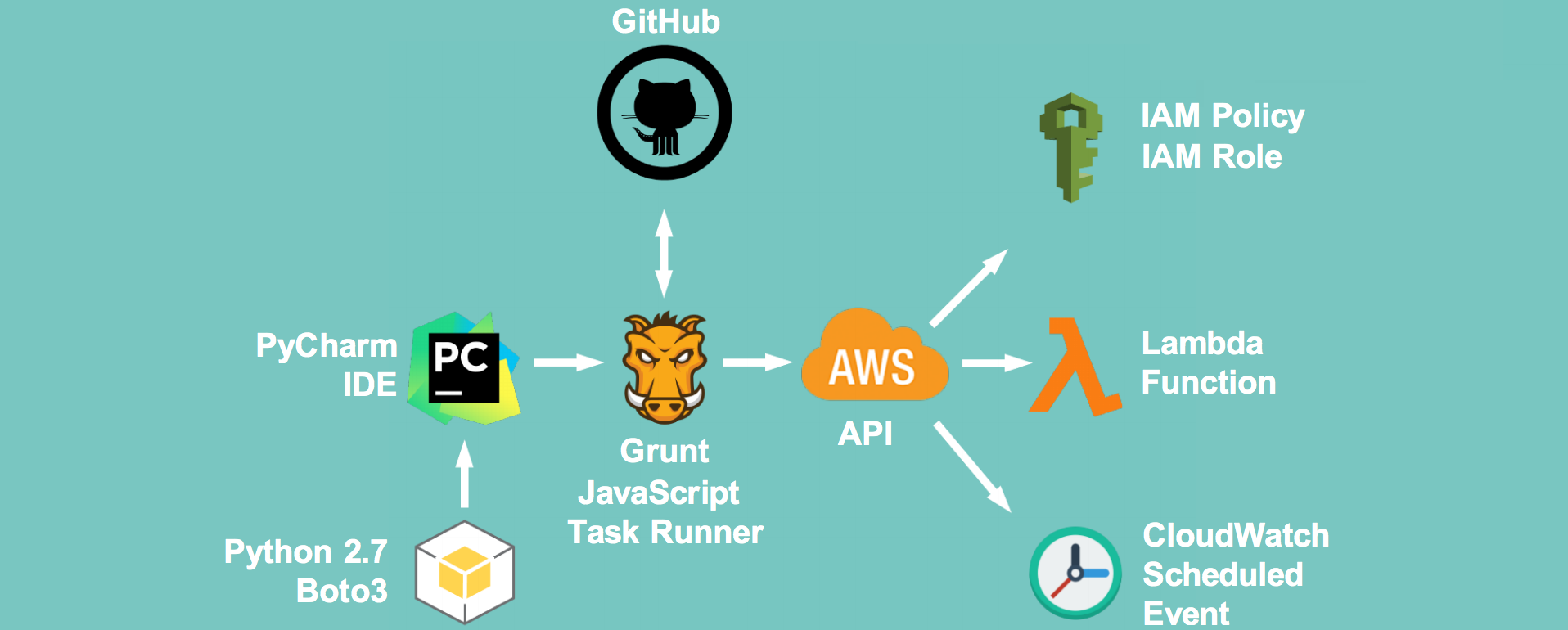The AWS Key disabler is a Lambda Function that disables AWS IAM User Access Keys after a set amount of time in order to reduce the risk associated with old access keys.
- A report containing the output (json) of scan will be sent to a single defined sysadmin account, refer to the
report_toattribute in the/grunt/package.jsonbuild configuration file. - Keys are only disabled, not deleted nor replaced
This script requires the following components to run.
- Node.js with NPM installed https://nodejs.org/en/
- Gruntjs installed https://gruntjs.com/
- AWSCLI commandline tool installed https://aws.amazon.com/cli/
It also assumes that you have an AWS account with SES enabled, ie domain verified and sandbox mode removed.
These instructions are for OSX. Your mileage may vary on Windows and other *nix.
- Grab yourself a copy of this script
- Navigate into the
/gruntfolder - Setup the Grunt task runner, e.g. install its deps:
npm install - Fill in the following information in
/grunt/package.json- Set the
aws_account_numbervalue to your AWS account id found on https://portal.aws.amazon.com/gp/aws/manageYourAccount - Set the
first_warningandlast_warningto the age that the key has to be in days to trigger a warning. These limits trigger an email send toreport_to - Set the
expiryto the age in days when the key expires. At this age the key is disabled and an email is triggered toreport_tonotifying this change - Set the
send_completion_reportvalue toTrueto enable email delivery via SES - Set the
report_tovalue to the email address you'd like to receive deletion reports to - Set the
report_fromvalue to the email address you'd like to use as the sender address for deletion reports. Note that the domain for this needs to be verified in AWS SES. - Set the
deployment_regionto a region that supports Lambda and SES. Also ensure that the region has SES sandbox mode disabled.- See the AWS Region table for support https://aws.amazon.com/about-aws/global-infrastructure/regional-product-services/
- Set the
- Ensure you can successfully connect to AWS from the CLI, eg run
aws iam get-userto verify successful connection - from the
/gruntdirectory rungrunt bumpup && grunt deployLambdato bump your version number and perform a build/deploy of the Lambda function to the selected region
Execute the lambda function by name, AccessKeyRotation, logging the output of the scan to a file called scan.report.log:
aws lambda invoke --function-name AccessKeyRotation scan.report.log --region us-east-1
{
"StatusCode": 200
}Use jq to render the contents of the scan.report.log to the console:
jq '.' scan.report.log
{
"reportdate": "2016-06-26 10:37:24.071091",
"users": [
{
"username": "TestS3User",
"userid": "1",
"keys": [
{
"age": 72,
"changed": false,
"state": "key is already in an INACTIVE state",
"accesskeyid": "**************Q3GA1"
},
{
"age": 12,
"changed": false,
"state": "key is still young",
"accesskeyid": "**************F3AA2"
}
]
},
{
"username": "BlahUser22",
"userid": "2",
"keys": []
},
{
"username": "LambdaFake1",
"userid": "3",
"keys": [
{
"age": 23,
"changed": false,
"state": "key is due to expire in 1 week (7 days)",
"accesskeyid": "**************DFG12"
},
{
"age": 296,
"changed": false,
"state": "key is already in an INACTIVE state",
"accesskeyid": "**************4ZASD"
}
]
},
{
"username": "apiuser49",
"userid": "4",
"keys": [
{
"age": 30,
"changed": true,
"state": "key is now EXPIRED! Changing key to INACTIVE state",
"accesskeyid": "**************ER2E2"
},
{
"age": 107,
"changed": false,
"state": "key is already in an INACTIVE state",
"accesskeyid": "**************AWQ4K"
}
]
},
{
"username": "UserEMRKinesis",
"userid": "5",
"keys": [
{
"age": 30,
"changed": false,
"state": "key is now EXPIRED! Changing key to INACTIVE state",
"accesskeyid": "**************MGB41A"
}
]
},
{
"username": "CDN-Drupal",
"userid": "6",
"keys": [
{
"age": 10,
"changed": false,
"state": "key is still young",
"accesskeyid": "**************ZDSQ5A"
},
{
"age": 5,
"changed": false,
"state": "key is still young",
"accesskeyid": "**************E3ODA"
}
]
},
{
"username": "ChocDonutUser1",
"userid": "7",
"keys": [
{
"age": 59,
"changed": false,
"state": "key is already in an INACTIVE state",
"accesskeyid": "**************CSA123"
}
]
},
{
"username": "ChocDonut2",
"userid": "8",
"keys": [
{
"age": 60,
"changed": false,
"state": "key is already in an INACTIVE state",
"accesskeyid": "**************FDGD2"
}
]
},
{
"username": "[email protected]",
"userid": "9",
"keys": [
{
"age": 45,
"changed": false,
"state": "key is already in an INACTIVE state",
"accesskeyid": "**************BLQ5GJ"
},
{
"age": 71,
"changed": false,
"state": "key is already in an INACTIVE state",
"accesskeyid": "**************GJFF53"
}
]
}
]
}- You can choose to set the message used for each warning and the final disabling by changing the values under
key_disabler.keystates.<state>.message - You can change the length of masking under
key_disabler.mask_accesskey_length. The access keys are 20 characters in length.
This script is provided as is. We are happy to answer questions as time allows but can't give any promises.
If things don't work ensure that:
- You can authenticate successfully against AWS using the AWSCLI commandline tool
- SES is not in sandbox mode and the sender domain has been verified
- The selected region provides both Lambda and SES https://aws.amazon.com/about-aws/global-infrastructure/regional-product-services/
Once the Lambda Function has been successfully deployed - the following commands can be performed:
aws lambda list-functionsopenssl dgst -binary -sha256 ..\Releases\AccessKeyRotationPackage.1.0.18.zip | openssl base64aws lambda invoke --function-name AccessKeyRotation report.log --region us-east-1jq '.' report.logjq '.users[] | select(.username=="johndoe")' report.logjq '.' report.log | grep age | cut -d':' -f2 | sort -n
jq 'def maximal_by(f): (map(f) | max) as $mx | .[] | select(f == $mx); .users | maximal_by(.keys[].age)' report.logjq 'def minimal_by(f): (map(f) | min) as $mn | .[] | select(f == $mn); .users | minimal_by(.keys[].age)' report.log


